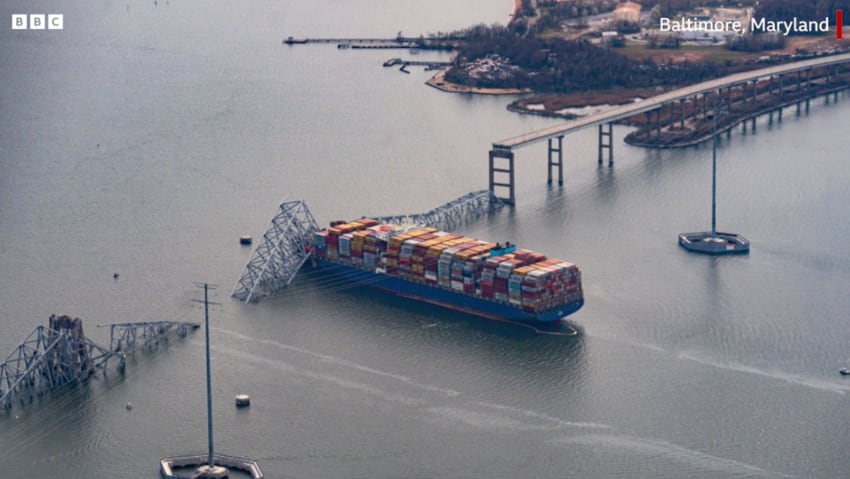Exactly how long the Port of Baltimore is closed to ships after yesterday’s collision and the subsequent collapse of the Francis Scott Key Bridge is unclear, but according to Julien Horn, Partner – Ports & Terminals and Logistics at broker McGill and Partners, “this may be the largest example of port blockage seen by the insurance market in recent years.”

Image source: BBC
After the Dali container ship collided with one of the bridge’s support beams in the early hours of yesterday morning local time, leading to a major collapse into the Patapsco River, the port remains closed to ships as the rescue operation continues.
According to Horn, this is likely a millions of dollars per hours question, which suggests that it could be the largest example of port blockage seen by insurers and reinsurers in recent times.
It brings into question business interruption insurance, and specifically a less common form of coverage which protects against port blockage or denial of access to the port.
Horn explains that this type of business interruption insurance effectively covers “ships being unable to gain access to the quay whether the blockage is directly at, adjacent to or from an obstacle 500 miles away.”
As highlighted by Horn, in 2021 the Suez Canal was blocked for a little over six days after the Ever Given container ship became lodged, causing significant blockage to world trade and lost revenue per day. The impact was far-reaching and other ports were fearful of the effect on trade if the Canal was blocked for a long time.
“The same worries are likely being contemplated by the port operators in Baltimore,” says Horn.
In terms of standard business interruption insurance for ports, which Horn explains protects against the loss of revenue after an accident that damages an insured’s owned or leased property, operators or ports and terminals often, but not always purchase this type of cover.
“This type of insurance is by no means mandatory and the decision to purchase it tends to be driven by the risk appetite of the port or the stakeholders, such as the banks or lenders, who demand the ports protect their income in the event of a catastrophe such as this,” says Horn.
“Establishing the quantum of a claim can be a significant challenge in a business interruption event as rather than paying a fixed amount per day or the total revenue declared on a pro rata basis for the time affected, any claim is subject to forensic scrutiny so operators, suppliers, and other third-party involvement will need to keep accurate records of their financial losses to establish the Business Interruption and work closely with their brokers and insurers.
“Unless the bridge was owned by the Port Authority or terminal operator, this cover would likely not be triggered,” he adds.
Additionally, Horn notes that secondary factors and levels of business interruption cover can include insurance to protect the increased cost of working for operators. This is where operators can spend a dollar to save a dollar of revenue. There’s also an additional increased cost of working factor, where operators can spend more than the lost revenue if it enables operators to maintain operations to prevent long-term harm to operations and revenue.
“The Port of Maryland Authority and the port operators and terminals of Baltimore will be counting the hours and enacting emergency response and disaster recovery plans that are likely to be in place. Insurers and other experts will be at the ready as recovery begins and we start to understand the wider ramifications,” says Horn.
It’s evident that this will be a very complex claim, and as stressed by Horn, potential liabilities extend beyond the rebuilding of the bridge and must consider removing the bridge debris which is on top of the ship and at the bottom of the river.
“The economic disruption and pain felt by businesses and individuals in Maryland and the Baltimore economic area will be widespread and likely take years to fully comprehend and compensate those affected,” warns Horn.
As we wrote previously, reinsurers are expected to bear the bulk of the cost of the insurance claim from this accident, with analysts highlighting the complexity of the claim and the significant economic cost that will take time to be fully understood.


